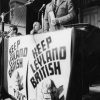In 1984, David Lynch distanced himself from his lurid, leaden $40million film adaptation of Frank Herbert’s dense 1960s space saga Dune by signing off as Alan Smithee, favoured pseudonym of chastened directors.
“I started selling out on Dune. Looking back,” said Lynch, “it’s no one’s fault but my own. I probably shouldn’t have done that picture, but I saw tons and tons of possibilities for things I loved, and this was the structure to do them in. There was so much room to create a world. But I got strong indications from [producers] Raffaella and Dino De Laurentiis of what kind of film they expected, and I knew I didn’t have final cut.”
The film was a commercial and critical disaster. “Within the first 10 minutes,” writes Daniel Snyder at The Atlantic, “the film bombarded audiences with words like Kwisatz Haderach, landsraad, gom jabber, and sardaukar with little or no context.” Unlike Star Wars, with its “blaster,” “droid,” and “force” – “words for made up things but they’re words that we know.” J. Hoberman’s review inm the Village Voice said is reminded him of a :seventh grade science project run amok”.
Universal Studios realised the problem. So they issued Dune‘s audiences with a glossary.
via io9
Would you like to support Flashbak?
Please consider making a donation to our site. We don't want to rely on ads to bring you the best of visual culture. You can also support us by signing up to our Mailing List. And you can also follow us on Facebook, Instagram and Twitter. For great art and culture delivered to your door, visit our shop.









